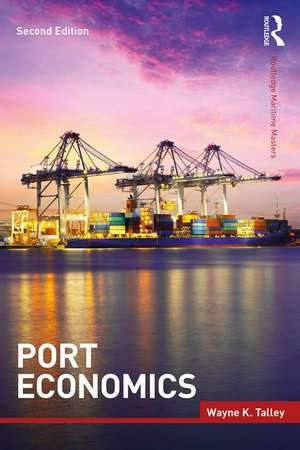Port Economics: Routledge Maritime Masters
Autor Wayne K. Talleyen Limba Engleză Paperback – 15 dec 2017
This text continues to enhance our understanding of port economics by exploring the economic theories, supply and demand curves, and the actual and opportunity costs relating to the carriers, shippers and passengers who use ports.
This new edition has been updated throughout. This includes:
- An expanded discussion of container, break-bulk, dry-bulk, liquid-bulk and neo-bulk ports;
- An introduction of port service chains, hinterland transport chains, maritime transport chains and port multi-service congestion;
- A discussion of seaborne trade, dry ports, port centrality and connectivity and free trade zones.
| Toate formatele și edițiile | Preț | Express |
|---|---|---|
| Paperback (1) | 487.79 lei 6-8 săpt. | |
| Taylor & Francis – 15 dec 2017 | 487.79 lei 6-8 săpt. | |
| Hardback (1) | 877.19 lei 6-8 săpt. | |
| Taylor & Francis – 15 dec 2017 | 877.19 lei 6-8 săpt. |
Preț: 487.79 lei
Preț vechi: 573.87 lei
-15% Nou
Puncte Express: 732
Preț estimativ în valută:
93.37€ • 101.45$ • 78.48£
93.37€ • 101.45$ • 78.48£
Carte tipărită la comandă
Livrare economică 21 aprilie-05 mai
Preluare comenzi: 021 569.72.76
Specificații
ISBN-13: 9781138952195
ISBN-10: 1138952192
Pagini: 286
Ilustrații: 46 Line drawings, black and white; 8 Halftones, black and white; 11 Tables, black and white; 54 Illustrations, black and white
Dimensiuni: 156 x 234 x 20 mm
Greutate: 0.41 kg
Ediția:2nd edition
Editura: Taylor & Francis
Colecția Routledge
Seria Routledge Maritime Masters
Locul publicării:Oxford, United Kingdom
ISBN-10: 1138952192
Pagini: 286
Ilustrații: 46 Line drawings, black and white; 8 Halftones, black and white; 11 Tables, black and white; 54 Illustrations, black and white
Dimensiuni: 156 x 234 x 20 mm
Greutate: 0.41 kg
Ediția:2nd edition
Editura: Taylor & Francis
Colecția Routledge
Seria Routledge Maritime Masters
Locul publicării:Oxford, United Kingdom
Public țintă
Postgraduate, Professional, and UndergraduateCuprins
Chapter 1: Introduction
Chapter 2: Cargo Ports: Operations
Chapter 3: Port Freight Service Users: Carriers
Chapter 4: Port Freight Service Users: Shippers
Chapter 5: Passenger Ports and Users
Chapter 6: Port Efficiency
Chapter 7: Port Effectiveness, Performance Evaluation and Investment
Chapter 8: Port Competition, Pricing and Cases
Chapter 9: Port Service Chains
Chapter 10: Hinterland Transport Chains
Chapter 11: Maritime Transport Chains
Chapter 12: Port Governance, Privatization, Concessions and Public–Private Partnerships
Chapter 13: Port Security and Safety
Chapter 14: Ports and the Environment
Chapter 15: Port Dockworkers
Chapter 16: Smart Capabilities: Ports, Ships, Cargo and Shipping Routes
Chapter 2: Cargo Ports: Operations
Chapter 3: Port Freight Service Users: Carriers
Chapter 4: Port Freight Service Users: Shippers
Chapter 5: Passenger Ports and Users
Chapter 6: Port Efficiency
Chapter 7: Port Effectiveness, Performance Evaluation and Investment
Chapter 8: Port Competition, Pricing and Cases
Chapter 9: Port Service Chains
Chapter 10: Hinterland Transport Chains
Chapter 11: Maritime Transport Chains
Chapter 12: Port Governance, Privatization, Concessions and Public–Private Partnerships
Chapter 13: Port Security and Safety
Chapter 14: Ports and the Environment
Chapter 15: Port Dockworkers
Chapter 16: Smart Capabilities: Ports, Ships, Cargo and Shipping Routes
Notă biografică
Wayne K. Talley is Professor of Maritime and Supply Chain Management, the Frederick W. Beazley Professor of Economics, Eminent Scholar and Executive Director of the Maritime Institute at Old Dominion University, Norfolk, Virginia, U.S.A.
Descriere
This book provides a detailed discussion of port freight service users such as freight water and land carriers that have their ships and vehicles, respectively, serviced by ports and have their cargoes unloaded from and to their ships and vehicles, respectively as well as a detailed discussion of port passenger service users such as passenger ferry carriers that have their ferry vessels and passengers serviced by ferry passenger ports. This text continues to enhance our understanding of port economics by exploring the economic theories, supply and demand curves, and the actual and opportunity costs, relating to the carriers, shippers and passengers who use ports.









